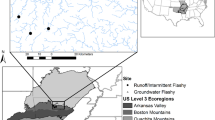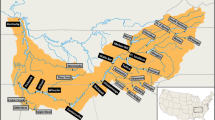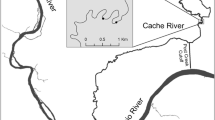Abstract
Understanding effects of flow alteration on stream biota is essential to developing ecologically sustainable water supply strategies. We evaluated effects of altering flows via surface water withdrawals and instream reservoirs on stream fish assemblages, and compared effects with other hypothesized drivers of species richness and assemblage composition. We sampled fishes during three years in 28 streams used for municipal water supply in the Piedmont region of Georgia, U.S.A. Study sites had permitted average withdrawal rates that ranged from < 0.05 to > 13 times the stream’s seven-day, ten-year recurrence low flow (7Q10), and were located directly downstream either from a water supply reservoir or from a withdrawal taken from an unimpounded stream. Ordination analysis of catch data showed a shift in assemblage composition at reservoir sites corresponding to dominance by habitat generalist species. Richness of fluvial specialists averaged about 3 fewer species downstream from reservoirs, and also declined as permitted withdrawal rate increased above about 0.5 to one 7Q10-equivalent of water. Reservoir presence and withdrawal rate, along with drainage area, accounted for 70% of the among-site variance in fluvial specialist richness and were better predictor variables than percent of the catchment in urban land use or average streambed sediment size. Increasing withdrawal rate also increased the odds that a site’s Index of Biotic Integrity score fell below a regulatory threshold indicating biological impairment. Estimates of reservoir and withdrawal effects on stream biota could be used in predictive landscape models to support adaptive water supply planning intended to meet societal needs while conserving biological resources.





Similar content being viewed by others
Literature Cited
Abell R. A., D. M. Olson, E. Dinerstein, P. T. Hurley, J. T. Diggs, W. Eichbaum, S. Walters, W. Wettengel, T. Allnutt, C. Loucks, P. Hedao. 2000. Freshwater ecoregions of North America: a conservation assessment. World Wildlife Fund, Washington, DC, 319 pp
Allison P. D. 1991. Logistic regression using the SAS system: theory and application. SAS Institute Inc., Cary, North Carolina, 288 pp
Armstrong, D. S., T. A. Richards, and G. W. Parker. 2001. Assessment of habitat, fish communities and streamflow requirements for habitat protection, Ipswich River, Massachusetts, 1998–99. US Geological Survey Water Resources Investigations Report 01–4161
Barbour, M. T., J. Gerritsen, B. D. Snyder, and J. B. Stribling. 1999. Rapid bioassessment protocols for use in streams and wadeable rivers: periphyton, benthic macroinvertebrates and fish, 2nd ed. EPA 841-B-99-002. Office of Water, U. S. Environmental Protection Agency, Washington, DC
Baron J. S., N. L. Poff, P. L. Angermeier, C. N. Dahm, P. H. Gleick, N. G. Hairston Jr., R. B. Jackson, C. A. Johnston, B. D. Richter, A. D. Steinman. 2002. Meeting ecological and societal needs for freshwater. Ecological Applications 12:1247–1260
Baxter R. M. 1977. Environmental effects of dams and impoundments. Annual Review of Ecology and Systematics 8:255–283
Bunn S. E., A. H. Arthington. 2002. Basic principles and ecological consequences of altered flow regimes for aquatic biodiversity. Environmental Management 30:492–507
Burnham K. P., D. R. Anderson. 2002. Model selection and multimodel inference: a practical information-theoretic approach. Springer-Verlag, New York, 488 pp
Burnham K. P., W. S. Overton. 1979. Robust estimation of population size when capture probabilities vary among animals. Ecology 60:927–936
Carter R. F., E. H. Hopkins, H. A. Perlman. 1986. Low-flow profiles of the upper Ocmulgee and Flint rivers in Georgia. US Geological Survey Water Resources Investigations Report 86–4176
Carter, R. F., E. H. Hopkins, and H. A. Perlman. 1988a. Low-flow profiles of the upper Savannah and Ogeechee rivers and tributaries in Georgia. US Geological Survey Water Resources Investigations Report 88–4047
Carter, R. F., E. H. Hopkins, and H. A. Perlman. 1988b. Low-flow profiles of the upper Oconee River and tributaries in Georgia. US Geological Survey Water Resources Investigations Report 88–4048
Clarke K. R. 1993. Non-parametric multivariate analysis of changes in community structure. Australian Journal of Ecology 18:117–143
Collares-Pereira M. J., I. G. Cowx, F. Ribeiro, J. A. Rodrigues, L. Rodago. 2000. Threats imposed by water resource development schemes on the conservation of endangered fish species in the Guadiana River Basin in Portugal. Fisheries Management and Ecology 7:167–178
Collier, M., R. H. Webb, and J. C. Schmidt. 1996. Dams and rivers: primer on the downstream effects of dams. USGS Circular 1126. US Geological Survey, Tuscon, Arizona
Conroy, M. J., C. R. Allen, J. T. Peterson, L. J. Pritchard, and C. T. Moore. 2003. Landscape change in the southern Piedmont: challenges, solutions, and uncertainty across scales. Conservation Ecology 8:3. [online]URL: http//www.consecol.org/vol8/iss2/art3
Cooperman M. S., D. F. Markle. 2003. The Endangered Species Act and the National Research Council’s interim judgment in Klamath Basin. Fisheries 28:10–19
Copp G. H. 1990. Effect of regulation on 0+ fish recruitment in the Great Ouse, a lowland river. Regulated Rivers: Research and Management 5:251–263
Fausch K. D., C. E. Torgersen, C. V. Baxter, H. W. Li. 2002. Landscapes to riverscapes: bridging the gap between research and conservation of stream fishes. Bioscience 52:483–498
Field J. G., K. R. Clarke, R. M. Warwick. 1982. A practical strategy for analyzing multispecies distribution patterns. Marine Ecology Progress Series 8:37–52
GDNR (Georgia Department of Natural Resources). 2000. Standard operating procedures for conducting biomonitoring on fish communities in the Piedmont ecoregion of Georgia. Georgia Department of Natural Resources, Wildlife Resources Division, Fisheries Section, Social Circle, Georgia
Gordon N. D., T. F. McMahon, B. L. Finlayson. 1992. Stream hydrology: an introduction for ecologists. John Wiley & Sons, Chichester, 526 pp
Jackson R. B., S. R. Carpenter, C. N. Dahm, D. M. McKnight, R. J. Naiman, S. L. Postel, S. W. Running. 2001. Water in a changing world. Ecological Applications 11:1027–1045
Karr J. R., E. W. Chu. 2000. Sustaining living rivers. Hydrobiologia 422/423:1–14
Kinsolving A. D., M. B. Bain. 1993. Fish assemblage recovery along a riverine disturbance gradient. Ecological Applications 3:531–544
Matthews W. J. 1990. Spatial and temporal variation in fishes of riffle habitats: a comparison of analytical approaches for the Roanoke River. American Midland Naturalist 124:31–45
Matthews W. J. 1998. Patterns in freshwater fish ecology. Chapman and Hall, New York, 756 pp
McCune, B., and M. J. Mefford. 1999. PC-ORD. Multivariate analysis of ecological data, Version 4.25. MjM Software Design, Gleneden Beach, Oregon
McCune B., J. B. Grace. 2002. Analysis of ecological communities. MjM Software Design, Gleneden Beach, Oregon, 300 pp
Moyle P. B., R. A. Leidy. 1992. Loss of biodiversity in aquatic ecosystems: evidence from fish faunas. In P. L. Fielder, S. K. Jain (eds.), Conservation biology: The theory and practice of nature conservation, preservation, and management. Chapman and Hall, New York. Pages 127–169
Naiman R. J., S. E. Bunn, C. Nilsson, G. E. Petts, G. Pinay, L. C. Thompson. 2002. Legitimizing fluvial ecosystems as users of water: an overview. Environmental Management 30:455–467
Oksanen, J., R. Kindt, and R. B. O’Hara. 2005. Vegan: Community Ecology Package. Available from http://www.cc.oulu.fi/~jarioksa/
Peterson J. T., C. F. Rabeni. 1995. Optimizing sampling effort for sampling warmwater stream fish for communities. North America Journal of Fisheries Management 15:528–541
Poff N. L., J. D. Allan, M. B. Bain, J. R. Karr, K. L. Prestegaard, B. D. Richter, R. E. Sparks, J. C. Stromberg. 1997. The natural flow regime. Bioscience 47:769–784
Postel, S. 1996. Dividing the waters: food security, ecosystem health, and the new politics of scarcity. Worldwatch Paper 132. Worldwatch Institute, Washington, DC, 76 pp
Postel S., B. Richter. 2003. Rivers for life: managing water for people and nature. Island Press, Washington, DC, 253 pp
Postel S. L. 2000. Entering an era of water scarcity: the challenges ahead. Ecological Applications 10:941–948
Richter B. D., J. V. Baumgartner, R. Wigington, D. P. Braun. 1997. How much water does a river need? Freshwater Biology 37:231–249
Roy A. H., M. C. Freeman, B. J. Freeman, S. J. Wenger, W. E. Ensign, J. L. Meyer. 2005. Investigating hydrologic alteration as a mechanism of fish assemblage shifts in urbanizing streams. Journal of the North American Benthological Society 24:656–678
Scott M. C., G. S. Helfman. 2001. Native invasions, homogenization, and the mismeasure of integrity of fish assemblages. Fisheries 26:6–15
Silk N., J. McDonald, R. Wigington. 2000. Turning instream flow water rights upside down. Rivers 7:298–313
Snijders T. A. B., R. J. Bosker. 1999. Multilevel analysis: an introduction to basic and advanced multilevel modeling. Sage Publications, London, 266 pp
Stalnaker, C., B. L. Lamb, J. Henrickson, K. Bovee, and J. Bartholow. 1995. The Instream Flow Incremental Methodology, a primer for IFIM. Biological Report 29. US National Biological Service, Washington, DC
Travnichek V. H., M. B. Bain, M. J. Maceina. 1995. Recovery of a warmwater fish assemblage after initiation of a minimum-flow release downstream from a hydroelectric dam. Transactions of the American Fisheries Society 124:836–844
Walters C. J. 1986. Adaptive management of renewable resources. Macmillan, New York, 374 pp
Walters D. M., D. S. Leigh, A. B. Bearden. 2003a. Urbanization, sedimentation, and homogenization of fishes in the Etowah River basin, USA. Hydrobiologia 494:5–10
Walters D. M., D. S. Leigh, M. C. Freeman, B. J. Freeman, C. M. Pringle. 2003b. Geomorphology and fish assemblages in a Piedmont river basin, U.S.A. Freshwater Biology 48:1950–1970
Walters D. M., M. C. Freeman, D. S. Leigh, B. J. Freeman, C. M. Pringle. 2005. Urbanization effects on fishes and habitat quality in a southern Piedmont river basin. In L. R. Brown, R. H. Gray, R. M. Hughes, M. R. Meador (eds.), Effects of urbanization on stream ecosystems. American Fisheries Society Symposium 47, Bethesda, Maryland. Pages 69–85
Ward F. A., J. F. Booker. 2003. Economic costs and benefits of instream flow protection for endangered species in an international basin. Journal of the American Water Resources Association 39:427–440
Warren M. L., Jr., B. M. Burr, S. J. Walsh, H. L. Bart Jr., R. C. Cashner, D. A. Etnier, B. J. Freeman, B. R. Kuhajda, R. L. Mayden, H. W. Robison, S. T. Ross, W. C. Starnes. 2000. Diversity, distribution, and conservation status of the native freshwater fishes of the southern United States. Fisheries 25(10):7–29
Weaver L. A., G. C. Garman. 1994. Urbanization of a watershed and historical changes in a stream fish assemblage. Transactions of the American Fisheries Society 123:162–172
Williams B. K., F. A. Johnson, K. Wilkins. 1996. Uncertainty and the adaptive management of waterfowl harvests. Journal of Wildlife Management 60:223–232
Williams B. K., J. D. Nichols, M. J. Conroy. 2002. Analysis and management of animal populations. Academic Press, San Diego, 817 pp
Acknowledgments
We appreciate field assistance provided by John Seginak, USGS, and the following students and technicians from the University of Georgia: Richard Weyers, Shane Hawthorne, Peter Esselman, Jesslyn Shields, Patricia Rodriguez, Sandra Helms, Leif Stephens, Judith Barkstedt, Clay Brady, Erica Curry, Megan Hagler, Sarah McClurg, Casey Storey, Dean Sedgewick, John Knight, and Allison Roy. Bud Freeman (UGA) and John Biagi and Patti Lanford (GDNR) provided logistic support and data for reference sites. This research was funded through the USGS State Partnership Program and by additional funding supplied by the GA Department of Natural Resources to the University of Georgia. The manuscript was substantially improved by comments from Jonathan Kennen, Mike Harris, Brett Albanese, Lance Williams, and three anonymous reviewers.
Author information
Authors and Affiliations
Corresponding author
Appendix
Appendix
Rights and permissions
About this article
Cite this article
Freeman, M.C., Marcinek, P.A. Fish Assemblage Responses to Water Withdrawals and Water Supply Reservoirs in Piedmont Streams. Environmental Management 38, 435–450 (2006). https://doi.org/10.1007/s00267-005-0169-3
Published:
Issue Date:
DOI: https://doi.org/10.1007/s00267-005-0169-3




